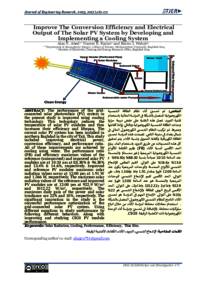Document
Yearly improvement of grid-connected solar PV system parameters by planar concentrators.
Source
Journal of Engineering Research, v. 19, no. 2, p. 140-151.
Contributors
Kasim, Naseer K. , Author
Hussain, Hazim H., Author
Other titles
التحسن السنوي لمعاملات نظام الطاقة الشمسية الكهروضوئية المتصلة بالشبكة بواسطة المركزات المستوية.
Country
Oman.
City
Muscat
Publisher
College of Engineering, Sultan Qaboos University.
Gregorian
2022
Language
English
Subject
English abstract
Planar concentrators are used in the current manuscript to improve the solar PV system parameters (electrical energy, array yield, and solar irradiation). Additionally, study the temperature (both the ambient temperature and the temperature of the PV modules), performance ratio, and efficiency. The current PV system is situated at Al-Taji town in Baghdad. These improvements are achieved by using planar concentrators to increase solar radiation (made of aluminium metal). The results demonstrated a 21% increase in the yearly average energy output for improved solar PV modules. The improved solar PV modules' average yearly array yield increased by 20.6%. Compared to the reference PV modules, the improved solar PV modules received 24% more solar irradiation yearly on average. The monthly average of the performance ratio (PR) and efficiency to the improved solar PV modules and reference solar PV modules are 89.3% & 13.61%, and 91.2% & 13.89%, respectively. The yearly average temperatures of the reference PV solar modules and improved PV solar modules are 48.8°C and 46.0°C, respectively, at an average ambient temperature of 29.2°C. The originality of this work is the successful improvement of the electrical energy of the grid-tied PV system, in addition to studying the performance of the second generation of photovoltaic solar modules (CIGS), where CIGS is the PV module technology that is used in this manuscript.
ISSN
Online: 1726-6742
Print: 1726-6009
Arabic abstract
تسُتخدم المركزات المستوية في البحث الحالي لتحسين معلمات نظام الطاقة الشمسية الكهروضوئية (الطاقة الكهربائية، وعائد المصفوفة، والإشعاع الشمسي). بالإضافة إلى ذلك، يتم دراسة درجة الحرارة (كل من درجة الحرارة المحيطة ودرجة حرارة الألواح الكهروضوئية)، ونسبة الأداء، والكفاءة. يقع النظام الكهروضوئي الحالي في بلدة التاجي ببغداد. يتم تحقيق هذه التحسينات باستخدام المركزات المستوية لزيادة الإشعاع الشمسي (المصنوعة من معدن الألمنيوم). أظهرت النتائج زيادة بنسبة 21% في متوسط إنتاج الطاقة السنوي للألواح الشمسية المحسنة. كما زاد متوسط العائد السنوي لمصفوفة الألواح الشمسية المحسنة بنسبة 20.6%. مقارنةً بالألواح الكهروضوئية المرجعية، تلقت الألواح الشمسية الكهروضوئية المحسّنة إشعاعًا شمسيًا أكثر بنسبة 24% سنويًا في المتوسط. متوسط نسبة الأداء والكفاءة الشهرية للألواح الشمسية الكهروضوئية المحسّنة والمرجعية هما 89.3% و13.61%، و91.2% و13.89% على التوالي. متوسط درجات الحرارة السنوية للألواح الشمسية الكهروضوئية المرجعية والمحسّنة هو 48.8°C و 46.0°C على التوالي عند متوسط درجة حرارة محيطة 29.2°C. تكمن أصالة هذا العمل في التحسين الناجح للطاقة الكهربائية للنظام الكهروضوئي المتصل بالشبكة، بالإضافة إلى دراسة أداء الجيل الثاني من الوحدات الكهروضوئية الشمسية (CIGS)، حيث أن CIGS هي تقنية الوحدة الكهروضوئية المستخدمة في هذا البحث.
Category
Journal articles

